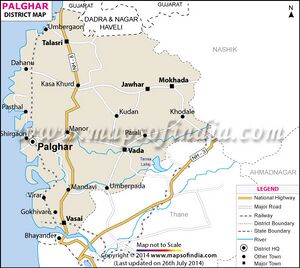Palghar
| Author:Laxman Burdak, IFS (R) |
Palghar (पालघर) is a town and district in the Konkan division of Maharashtra state, India.
Location
Palghar lies on the Western Line of the Mumbai Suburban Railway in the busy Mumbai-Ahmedabad rail corridor. The town is located about 87 km north of Mumbai, about 35 km north of Virar and about 24 km west of the Mumbai-Ahmedabad National Highway at Manor.
Tahsils
Palghar district comprises the talukas:
History
On 1 August 2014, Palghar became the 36th district of Maharashtra. Its history is alternate with its old district Thane. Jawhar, Vasai and Palghar tehsils have a historical legacy. Vasai (then known as Bassein) was under the Portuguese Empire. Chimaji Appa, the Maratha military commander later captured Vasai fort from the Portuguese and embedded the Maratha flag on Vasai.
Uprising against the British : Palghar was one of the important points in 1942 of the Chalejav campaign. On 14 August 1942, there was an uprising against the British in Palghar, in which Kashinath Hari Pagdhare, Govind Ganesh Thakur, Ramprasad Bhimashankar Tiwari, Ramchandra Mahadev Churi, and Govind Sukur More were killed. The main circle of Palghar is known as "Paachbatti" (which means 'five lights' in Marathi) in honour of these martyrs. 14 August has been declared "Martyrs Day" in Palghar, when people gather at Paachbatti Circle to honour the five who sacrificed their lives for Indian
People
Kunbi, Bhandari, Warli (Adivasi), Katkari, Malhar Koli, Vanjari, Vadval, Mali (Sorathi) are the predominant castes in Palghar. The Vanjaris are a nomadic tribe that have their roots in Chittorgarh, Rajasthan. Their language is distinct from standard Marathi as it has a high influence of Rajasthani and Gujarati.
Vadval is the most numerous community present in Palghar. They are said to be the descendants of Yadava dynasty of Devagiri who established themselves here. They form one of the very few Marathi-speaking communities which belong to Kshatriya varna but not the traditional 96-clan (96 - Kuli) Maratha caste.
Warli Painting and famous Tarapa dance features contribution towards art by the Warli community. Warli painting and art stretch back to a millennium. Warli art is also appreciated in foreign countries. Warlis represent the earliest settlers of the land around the present times and their culture has largely influenced the later cultures in and around the area.
The Koli (fishermen) community of Palghar is a reminder of the city's links with the Arabian Sea. Fisheries form a large part of trade and diet of Palghar and also take up a major role in cultural events. The Kolis are further divided into subcastes such as Vaiti, Mangele, Bari, etc.
Tourist attractions
Tourist attractions in the district include:
- Arnala fort
- Vasai Fort
- Gambhirgad
- Kaldurg Fort
- Kelwa Beach
- Kamandurg Fort
- Shirgaon Fort
- Tandulwadi Fort
- Vajreshwari hot water spring
- Mahalakshmi Temple
- Jivdani Mata temple
- Bhavangad Fort
